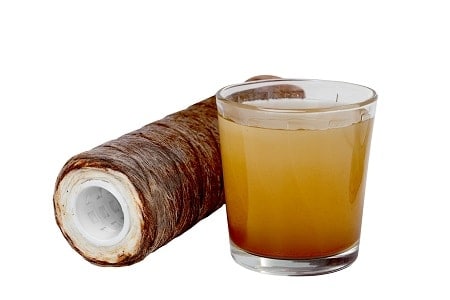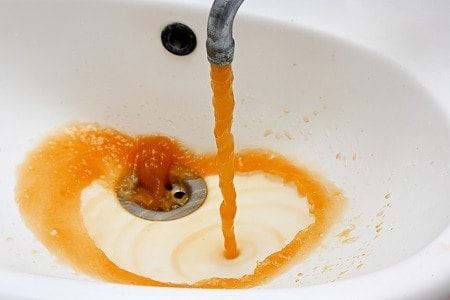Iron Water Problems in Your Home
Common Questions About Iron Water
What is Iron Water?

Iron water contains a high level of one or two types of iron content:
- Ferric iron is a type of iron that belongs to the sediment family. It is iron that you can visibly see, as it has been oxidized, and can be captured in a filter.
- Ferrous iron (or “clear water iron”) is iron dissolved in your water that has not yet been oxidized, or exposed to oxygen. It cannot be captured in a filter like ferric iron and requires a different kind of treatment, like a water softener.
How Does Iron Get into Well Water?
Having a high level of iron content in your well water means that more than likely you have “iron bearing” rocks underneath your property or that your groundwater source has been exposed to “iron bearing” minerals.
When it rains, water seeps down and into your soil. As it moves through the soil, it passes through rock that contains iron deposits, dissolves it, and carries it with it until it hits the aquifers that serve as the sources of groundwater for your well. If you have iron water issues, rainwater is running into iron formations underneath your property or nearby before it gets into the aquifer that your well uses.
Is Water With a High Level of Iron Bad for You?
No, iron in your drinking water is not typically harmful. The EPA classifies iron as a secondary contaminant, and therefore there are no known health risks. Despite this, it is a nuisance for your home and your pocketbook. It will ruin everything from sinks and toilets to clothes to even your driveway.
How Can Iron Water Damage Your Home?
Although water won’t necessarily damage your health, iron in your well water system will destroy plumbing and appliances. It can also make food and beverages taste funny.
Stains
Iron in well water will stain anything it touches, and the higher the level of iron, the greater the staining will be. It can be fairly difficult or impossible to remove iron stains from fixtures.
The telltale signs are the color of the stains: iron water leaves red, yellow, and brown stains. These stains can appear on your laundry, your dishes, your sinks, and your tubs. They can even appear on your sidewalks, walkways, and driveways from sprinkler water.
Clogs
When iron travels with water, it can end up settling on anything water touches. Typically this is water that contains ferric iron – the iron sediment that is not dissolved in water. Over time this iron can accumulate and clog your plumbing, dishwashers, washing machines, sprinklers, wells, water pumps, and other appliances and accessories. The accumulation can damage your appliances, requiring expensive repairs and replacements.
Signs of an Iron Water Problem in Your Home
- Your drinking water has a metallic taste or an unpleasant smell.
- Your water appears to be discolored, either right when it comes out of the tap or after it sits for a few minutes.
- If it comes out red, yellow, or orange right from the tap, you probably have ferric iron present in your well water. This usually happens after the iron has come into contact with oxygen and started to rust somewhere in your water supply.
- If it comes out clear from the tap, but turns red or brown after it sits, you probably have ferrous iron in your water.
- You have orange or rust-colored rings around your bathtub or sink.
- You have brown or yellow stains on your clothes and dishes.

How Can I Remove Iron from My Water?
If you are experiencing problems with iron in your water, there are two approaches we recommend to remove iron. These methods can include various combinations of water filters, treatments, water softeners, and iron removal filters. Our water consultants can design the most appropriate solution depending on the specific needs of your home water supply.
Treating Ferrous Iron: Water Softeners and Air-Aspirated Filters (AIV)
Since ferrous iron is dissolved in water, it requires water treatment equipment that uses the ionic exchange principle. This is a fancy way of saying you need equipment that switches the iron in the water for something else.
- The most common way to deal with clear-water iron is to install a water softener in your home or business.
- However, sometimes homeowners do not want to soften their water. In those instances there is a second way to treat iron water by installing an air-aspirated filter (AIV). This equipment injects oxygen into the water, turning ferrous iron into ferric iron. This method will then need to be paired with the iron filtration treatments listed below.
Treating Ferric Iron: Cartridge Filters and Backwashing Sediment Filters
Since ferric iron is not dissolved in water, it is treated differently. This form of iron can be captured using filters, but the kind of filter you want to install and use depends on how much iron is in your water.
- Homes that contain smaller amounts of iron typically want to install cartridge filters to capture and remove the iron in the water supply.
- Homes with significant amounts of iron want to install a backwashing sediment filter and then possibly a smaller cartridge filter, depending on the extent of the problem.
EcoWater Water Conditioners >>
EcoWater Water Refining System >>
Is Your Water Discolored? Do You Have Stained Fixtures?

